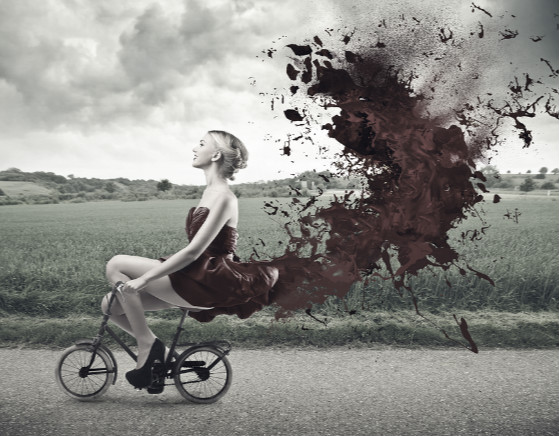Do It by Bike: A Roadway of Ascension.

{source}
I’ve already driven this route perhaps half a dozen times.
In an air-conditioned, motorized vehicle with plush upholstered seats in which the barest flick of a big toe grazing a rubber-coated pedal engages forward thrust. Golden fields dotted with farmhouses, and the paved grid of country roads that cuts through them, as of yet contains no feeling, sparks no energy, offers no verve.
In that seat, a numb potential mechanically drives in a prison behind glass, unregistered as a sensitive being built to feel and awaken and vitalize as the day approaches its zenith.
In wild contrast, everything, including myself, comes alive when I traverse this angular route by bike.
From an open-air, fully-exposed perch on the saddle, the colors pop, the breeze viscerally asserts itself as a constant against body and bike, and Western meadowlarks arc and bank left, suddenly disturbed in their flight pattern as they come across this unwieldy contraption of overloaded bike and human being on her perpetual motion machine.
Until I get from point A to point B by cycling the in-between miles, what I might call deep immersion is a hazy possibility, an unborn potential, an unclaimed inhabitation.
A simple taste of the free-spirited, open-road, rockin’ down the highway kind of nomadic life, however, restores the severed link that isolates the individual from feeling-full extension into the environment, overturning the conviction of one’s absolute separation from everything else.
Deep immersion, far removed from those insulated in vehicles whose temperature is regulated and speed easily modulated, almost instantly reinstates in maybe two or twelve pedal strokes as a cyclist exerts through warm air ebbing and flowing as movement between the microbe-rich soils and solar radiation brightly energizing these fields.
Because cycling in this here-and-now is connected, like links in a bicycle chain, to the manifold times that it has successfully wrenched open a kind of portal into this full-on worldly and sensory-rich experience, the transition feels seamless: memories of road cut through and along and over dunes, mountain chains, rock tunnels, mile-and-a-half steel bridges, wide bays, coastal megalopolises, redwood groves, and estuaries remind me of my existence as a sun-baked, wind-whipped, sweat-soaked child of Nature who can never find her sole sustenance in ivory towers alone.
Cycling evokes the smell of fields of orange trees from some past ride, sweet tangy citrus intermixing with mineralized dirt in these dry plains, entertaining and enriching, bottom-up and top-down sensory input pouring into this sustained movement.
Sensations, usually dulled and blunted through perceptual channels attenuated and atrophied, startle me with color, light, and the arresting form of birds with electric yellow underbellies. Waves of heat come and go, taken away by rolling cloud cover that send little, zappy shivers down bare arms that have acquired a sweaty film.
The bike steadily heaves forward, along a slower groove, next to a car that sails around corners in a kind of hurry-sick destination fixation, plunging my exposed body pedal stroke-by-pedal stroke further into union, synch, and intimate relation with the raw, rugged landscape.
Goldenrod-flecked short grass prairie scratches at my bare legs sounding like a gruff rustle. Insects buzz, chirp, and pop out of left field to land their arthropodic bodies on hot pavement around the rotations of my front tire.
The pavement fissures into craggy cracks and potholes that fill with sand, weed, and roadside debris: errant plastic caps, nondescript strips of black rubber, unruly industry flaking off into fragments. The road’s sharp intensity, its elemental sting, its rude awakening, traversed by motor power and cushy tires, is blotted out.
There are two perpendicular country roads I take toward an afternoon at a small-town café per my usual predilections. One faces due west, a straight plumb line whose horizon line exceeds visual limits, appearing to stretch up and into the towering range of mountains ahead.
If you imagine that you are headed all the way to what they call the Wild Coast, like masses did in their horse-drawn wagons and aboard steam-powered trains during Westward Expansion, you would have gotten used to these shades of umber, ochre, and dusky yellow by now.
If you imagine you are doing so by modern means, using some portion of the infrastructure made up of millions of miles of road, transportational channels laid over upturned soil, do it by bike.
This mountain range straight ahead would inform you that a phase is about to change, a topographical alchemy converting field to formidable continental uplift. These impressive rollers whose relentless, brawny wind gusts test your endurance mindset, this endless flat belt of prairie dotted with the occasionally interesting silo, dilapidated ranch, or pit stop, is about to get vertically complex.
It excites you as much as it makes you tremble.
The Rocky Mountain interior is a thick challenge of greens, a coniferous carpet of unbroken mixed montane forest that has, betwixt barren granite outcroppings, aggressively seized any and all parcels of lumpy heaves of raised earth as a canvas for its propitious growth.
Herds and hordes of elk and deer and bison and black bear, bands of Ute and Arapaho on foot and horseback, occasional pumas and eagles, and, even more unlikely, lynx, have crowded into the upper reaches of uplift, escaping the penetrating mile-high heat, hiding behind scrub and rock, blending in with the ubiquitous scent of dust, sap, and pine.
Once it was rather quietly this and only this, until Development took on the challenge of laying the infrastructure of carving miles of tunnels into thick slabs of mountainsides, of constructing cantilever bridges over roughshod gorges, and paving continuous, circuitous strips of durable road over ridiculously steep grades that could carry cars, trucks, RVs, and 18-wheelers.
Do it by bike because a cyclist can adapt these routes laid down for other purposes as portages of pilgrimage. This web of roadways quietly beckons, waiting for your eager readiness, for your sweat, your steering, and the kind of spiritual fortitude that shouts “bring it on” between gasps of air, adjustments of helmet strap, and clumsy grasps for a water bottle.
These roadways are matrices, are moving mats of yoga connecting body, breath, and bike, are exercises of ascension; pavement becomes a thin magic carpet ride in which a cyclist crawls and pushes and begs and pleads and wobbles and meticulously weaves along an undulating, switch-backing path until mileage you can realistically cover per day drastically reduces.
You keep going slowly but surely until reaching the Continental Divide where the air is thin and the mind rarefies into diamond clarity as passes at 12,500 feet scrape the basin of the heavens. You take some photos to capture the soul who made it part-exasperated, part-elated, rippling with ecstatic energy to descend carefree and under the spell of post-exertion elation, down the other side.
Persisting, a cyclist who began on the goldenrod-flecked plains, will encounter the Colorado Plateau, the vast, arid Utah and Nevada deserts, the salt flats, the hilly Sierra Nevadas, then pockets of Redwoods. All of this stands in between the one who, in fields and farmland, merely postulates a jagged coastline, separated from the ocean’s negative ions and its sultry, soothing, sweet song.
With adequate imagination, yearning, and steadfast belief, a cyclist might taste the salt spray that sea foam releases as it crashes into rocks jutting out of the oceanic belly in which they reside, whose deep blue is anticipated only perhaps in the few spots on the back of a beetle grazing the plump sunflowers from where she came.
One unbroken road that will make its patient way across grasslands, mountains, deserts, and basins, she knows, when under sway of such delicious meditations on connectivity and the seamlessness of here and there united by subtle links ordinarily overlooked, that all movement and momentum, when flow is unimpeded, gathers into a current that carries everything inevitably to the sea.
[youtube]Ts9nmYUIlB8[/youtube]
***

Sarah McKelvey is a free spirit who enjoys introspecting, speculating, and writing about life, love, synchronistic experiences, identity, psyche, self-cultivation, and her various misadventures. She typically writes in the context of traveling, and is informed by Eastern wisdom traditions, depth psychology, and the iconoclastic teachings of Alan Watts. Words are her favorite medium. In her pursuits, she pursues truth, beauty, and goodness, and hopes to, through her endeavors and writing, promote a life-affirming attitude that belongs on the spectrum of love. She lives along the Front Range outside of Denver, and practices psychotherapy professionally.

